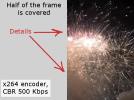Suslik V
Active Member
@qhobbes Realtime render is not always rendered the same. Artist can place random animations to crowd, grass, weather and physics etc (that will be slightly different at each run). For example, in old tests of encoders (link was posted above) OBS source was fed with prerecorded video at high resolution and very high quality (yeah, it wasn't realtime 3D render).
Anti-aliasing techniques in render can improve quality of the final video when you are using H.264 like encoders -> less edges ("ladder") = higher quality. Streamers may try to avoid contrast objects in the composition (camera on top of the video usually has sharp edges that is not good, but if it is large enough - it will cover unpredictable background). T-shirt with fine detailed picture will take additional bits for compression... There are many things that can be done outside encoder settings.
Anti-aliasing techniques in render can improve quality of the final video when you are using H.264 like encoders -> less edges ("ladder") = higher quality. Streamers may try to avoid contrast objects in the composition (camera on top of the video usually has sharp edges that is not good, but if it is large enough - it will cover unpredictable background). T-shirt with fine detailed picture will take additional bits for compression... There are many things that can be done outside encoder settings.
Last edited:



